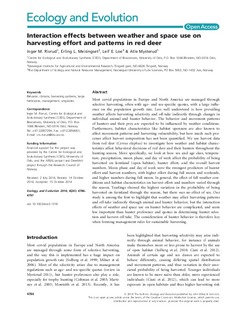| dc.contributor.author | Rivrud, Inger Maren | |
| dc.contributor.author | Meisingset, Erling L. | |
| dc.contributor.author | Loe, Leif Egil | |
| dc.contributor.author | Mysterud, Atle | |
| dc.date.accessioned | 2015-02-09T10:13:00Z | |
| dc.date.accessioned | 2018-05-29T09:18:11Z | |
| dc.date.available | 2015-02-09T10:13:00Z | |
| dc.date.available | 2018-05-29T09:18:11Z | |
| dc.date.issued | 2014 | |
| dc.identifier.citation | Ecology and Evolution 2014, 4:4786-4797 | nb_NO |
| dc.identifier.issn | 2045-7758 | |
| dc.identifier.uri | http://hdl.handle.net/11250/2499531 | |
| dc.description.abstract | Most cervid populations in Europe and North America are managed through selective harvesting, often with age‐ and sex‐specific quotas, with a large influence on the population growth rate. Less well understood is how prevailing weather affects harvesting selectivity and off‐take indirectly through changes in individual animal and hunter behavior. The behavior and movement patterns of hunters and their prey are expected to be influenced by weather conditions. Furthermore, habitat characteristics like habitat openness are also known to affect movement patterns and harvesting vulnerability, but how much such processes affect harvest composition has not been quantified. We use harvest data from red deer (Cervus elaphus) to investigate how weather and habitat characteristics affect behavioral decisions of red deer and their hunters throughout the hunting season. More specifically, we look at how sex and age class, temperature, precipitation, moon phase, and day of week affect the probability of being harvested on farmland (open habitat), hunter effort, and the overall harvest numbers. Moon phase and day of week were the strongest predictors of hunter effort and harvest numbers, with higher effort during full moon and weekends, and higher numbers during full moon. In general, the effect of fall weather conditions and habitat characteristics on harvest effort and numbers varied through the season. Yearlings showed the highest variation in the probability of being harvested on farmland through the season, but there was no effect of sex. Our study is among the first to highlight that weather may affect harvesting patterns and off‐take indirectly through animal and hunter behavior, but the interaction effects of weather and space use on hunter behavior are complicated, and seem less important than hunter preference and quotas in determining hunter selection and harvest off‐take. The consideration of hunter behavior is therefore key when forming management rules for sustainable harvesting. | nb_NO |
| dc.language.iso | eng | nb_NO |
| dc.rights | Navngivelse 4.0 Internasjonal | * |
| dc.rights.uri | http://creativecommons.org/licenses/by/4.0/deed.no | * |
| dc.subject | Behavior | nb_NO |
| dc.subject | climate | nb_NO |
| dc.subject | harvesting patterns | nb_NO |
| dc.subject | large herbivores | nb_NO |
| dc.subject | ungulates | nb_NO |
| dc.subject | management | nb_NO |
| dc.title | Interaction effects between weather and space use onharvesting effort and patterns in red deer | nb_NO |
| dc.type | Journal article | nb_NO |
| dc.type | Peer reviewed | nb_NO |
| dc.date.updated | 2015-02-09T10:13:00Z | |
| dc.description.version | publishedVersion | nb_NO |
| dc.rights.holder | (C) 2014 The Authors.Ecology and Evolutionpublished by John Wiley & Sons Ltd.This is an open access article under the terms of the Creative Commons Attribution License, which permits use,distribution and reproduction in any medium, provided the original work is properly cited. | nb_NO |
| dc.source.pagenumber | 4786-4797 | nb_NO |
| dc.source.volume | 4 | nb_NO |
| dc.source.journal | Ecology and evolution | nb_NO |
| dc.source.issue | 24 | nb_NO |
| dc.identifier.doi | 10.1002/ece3.1318 | |
| dc.identifier.cristin | 1217006 | |
| dc.relation.project | Norges forskningsråd: 179569 | nb_NO |

